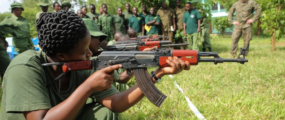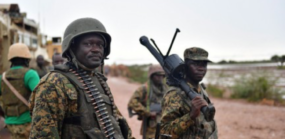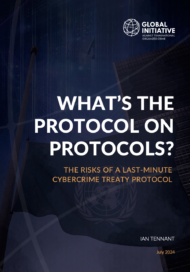Sarah Parker, policy support officer for the Arms Trade Treaty, speaks to the Global Initiative about the impact of the ATT, its complementarity with other weapons instruments and the international response to the treaty.
GI: What was the genesis of the ATT and the problem it was originally negotiated to address?
SP: The idea of an international treaty governing the arms trade first arose in 1925 at the League of Nations, and since then it has gone through several metamorphoses. The impetus for the ATT in its current form, however, began some 20 years ago, when Nobel Peace Prize Laureate Óscar Arias (and former president of Costa Rica) produced a declaration signed by several other Nobel laureates pushing for a treaty on the arms trade.
It then took several years of discussions, and two rounds of negotiations (in 2012 and 2013), neither of which could achieve consensus So the treaty was adopted by a resolution in the UN General Assembly in April 2013.
The main objectives of the treaty are to reduce human suffering and establish common international standards, so that everybody applies the same criteria when selling weapons. The focus had been on imports and exports, but, for much of the world, the major issue is illicit trafficking and diversion. Preventing the illicit trade as a secondary objective came later.
GI: Why did the member states feel that this new treaty would be necessary, given that there were pre-existing international instruments, such as the UNTOC Firearms Protocol? Hadn’t the issue already been dealt with?
SP: Indeed, there were already the Programme of Action on Small Arms (PoA) and the Firearms Protocol (FP) – both adopted in 2001. It may initially seem strange that two instruments were adopted in the same year that have so much common ground. But the FP is very much about taking a crime-prevention approach, which is why it contains provisions on mutual legal assistance, investigative techniques and prosecution, and so on. The PoA is more about managing stockpiles, and marking and tracing weapons, and so on, which are measures to prevent illicit trafficking.
The main difference with the ATT is that it deals with all conventional weapons, not just small arms and light weapons, like the other two instruments. It also deals with battle tanks, armoured combat vehicles, helicopter gunships, warships, and everything in between. So it is more comprehensive than the other instruments in terms of its scope. The new treaty also gives states something new to invest their energy in, a new hope, a new angle and a different perspective on the issue. So there is some complementarity, reasons why they coexist.
GI: How does the ATT deal with overlaps with these existing instruments?
SP: The ATT actually enhances certain aspects of the PoA and FP that are not very detailed, and vice versa. For example, both the PoA and the FP talk about the need for states to have international transfer controls, but they don’t go into a lot of detail, whereas this is covered by some of the core provisions of the ATT. Article 7 lays out how to – I paraphrase – assess the risks should the transfer of weapons contribute to or undermine peace and security, and if such items might be used to commit a serious violation of human-rights law, or if it might be an act constituting an offence under international conventions or protocols relating to transnational organized crime, to which the exporting state is a party. So, it elaborates much more than the FP and the PoA do on the risks that states should consider when assessing a transfer.
At the same time, the main provision in the ATT that aims to prevent illicit trafficking (Article 11, on diversion) says that states need to prevent and address diversion of weapons into the illicit trade. But it doesn’t tell them how to do it. Whereas, if you look at the PoA and the FP, they contain all the measures needed to prevent and address diversion, such as marking and tracing, stockpile management and so on. So there’s complementarity: they build on and enhance one another.
GI: If states parties to the treaty are not adhering to these provisions about the illicit trade, what sort of mechanisms then come into play?
SP: That’s a tricky question. Weapons trading is a very sensitive subject, which is what makes it interesting but also challenging: there is the economic side, the security side, its role in political alliances, and so on.
During the negotiations, there was discussion on the need for some kind of review mechanism but, in the end, this was not included in the treaty. The treaty gives states parties the framework to make decisions but, ultimately, states have discretion in terms of how to apply it. There’s a dispute-settlement clause, like there is in all treaties, that would allow states to go to arbitration, but it has not yet been exercised. Of course, civil society is always able to take action and use the ATT as a framework to challenge government decisions, as seen in the Campaign Against the Arms Trade case brought against the UK government.
GI: So, given that the focus from Security Council resolutions is mainly on Africa and the Middle East at the moment, how are these regions responding to the ATT?
SP: Africa – very positively. African states were very supportive and active during the negotiations. They wanted this treaty. We run something called the ‘voluntary trust fund’ and the majority of applications have been from African states who want to join the treaty, and want assistance to do that.
In particular, in the West African ECOWAS region we have a very high participation rate, there are only two states that are not states parties.
The Middle East is a different story: there is very little participation so far. We have a few states parties from the MENA region and several signatories, but the majority of states in the region have not joined the treaty. Nevertheless, the majority of the world’s top 50 arms exporters have joined the treaty.
GI: Does the fact that illicit arms are mentioned in Target 16.4 of the Sustainable Development Goals have an impact on how the ATT is working?
SP: Absolutely! The SDG agenda is a very helpful boost to the whole process, and will breathe some new life into implementing the ATT as well as other instruments, as it makes states see the connection to development and establishes another objective for the ATT: to help states achieve the SDGs. There have already been several discussions specifically on the issue of the synergies between the SDGs and the ATT, and how the ATT can help contribute towards the achievement of the SDGs.
Tratado sobre Comercio de Armas: ¿un tratado diferente?
Sarah Parker, asesora de políticas para el Tratado sobre el Comercio de Armas (TCA), habla con la Iniciativa Global sobre el impacto de este tratado, su complementariedad con otros instrumentos sobre armas y la respuesta internacional.
GI: ¿Cuál fue la génesis del TCA y el problema por el que originalmente se negoció?
SP: La idea de un tratado internacional para regular el comercio de armas surgió por primera vez en 1925 en la Liga de las Naciones; desde entonces, ha pasado por varias transformaciones. El ímpetu por el TCA actual comenzó hace unos 20 años, cuando Oscar Arias (Premio Nobel de la Paz y ex presidente de Costa Rica) formuló una declaración que fue suscrita por varios galardonados con el Nobel que presionaban por un tratado para el comercio de armas.
Luego vinieron varios años de debate y dos rondas de negociación (en 2012 y 2013) en las que no se pudo llegar a un consenso, por lo que el tratado terminó siendo adoptado por una resolución de la Asamblea General de la ONU en abril de 2013.
Los principales propósitos del tratado son reducir el sufrimiento humano y establecer estándares comunes internacionales para que todos puedan aplicar el mismo criterio al momento de comercializar armas. El foco había estado puesto sobre importaciones y exportaciones, pero, para gran parte del mundo, la principal preocupación es el tráfico ilícito. La prevención del contrabando de armas como objetivo secundario vino después.
GI: Dado que ya existían instrumentos internacionales sobre armas, como el Protocolo de Armas de Fuego de la UNTOC ¿Por qué sentían los Estados miembros que era necesario un nuevo tratado? ¿No se había abordado ya este asunto?
SP: Es cierto, ya estaba el Programa de Acción sobre Armas Pequeñas (PdA) y el Protocolo de Armas de Fuego (PAF), ambos adoptados en 2001. Puede parecer extraño que en un mismo año se hayan adoptado dos instrumentos que tienen tanto en común, pero el PAF tiene un enfoque hacia la prevención del delito – por eso contiene disposiciones sobre asistencia jurídica mutua, técnicas de investigación y procesamiento, etc. El PdA trata más sobre la gestión de excedentes, el marcado y el rastreo de armas, etc., que son medidas orientadas a prevenir el tráfico ilícito.
La principal diferencia con el TCA es que este nuevo tratado se ocupa de todas las armas convencionales, no sólo de las armas pequeñas y ligeras, como los otros dos instrumentos. También abarca tanques de guerra, vehículos de combate blindados, helicópteros de ataque, buques de guerra, y todo lo que esté entre medio. Por tanto, es más amplio que los otros dos instrumentos en términos de alcance. Además, el TCA le da a los Estados algo nuevo en donde invertir sus energías, una nueva esperanza, un nuevo ángulo y una perspectiva diferente sobre el asunto. Es por ello que existen un grado de complementariedad y razones por las que coexisten.
GI: ¿Cómo resuelve el TCA las superposiciones con los instrumentos existentes?
SP: El TCA en realidad refuerza ciertos aspectos que no están muy detallados ni en el PdA ni el el PAF, y vice versa. Por ejemplo, tanto el PdA como el PAF hacen mención de la necesidad de que los Estados implementen controles sobre transferencias internacionales, pero no entran en mucho detalle, algo que sí hacen las disposiciones del TCA. El Artículo 7 – voy a parafrasearlo – establece cómo evaluar los riesgos en caso de que la transferencia de armas contribuya positiva o negativamente a la paz y la seguridad, si pudieran utilizarse para cometer violaciones graves a los derechos humanos, o si pudiera ser un acto que constituya un delito según los convenios o protocolos internacionales en materia de delincuencia organizada trasnacional de los que el país exportador sea parte. Por tanto, elabora mucho más que el PAF y el PdA sobre los riesgos que los Estados deben considerar al momento de evaluar una transferencia.
Al mismo tiempo, la principal disposición del TCA encaminada a prevenir el contrabando (Artículo 11, sobre desvíos) dice que los Estados necesitan prevenir y abordar los desvíos de armas en el comercio ilícito, pero no dice cómo hacerlo. Sin embargo, si miras el PdA y el PAF, ambos contienen todas las medidas necesarias para prevenir y abordar los desvíos, como el marcado y el rastreo, la gestión de excedentes, entre otros. Entonces, sí que hay una complementariedad: se construyen uno sobre el otro.
GI: Si los Estados Parte del tratado no adhieren a estas disposiciones sobre el comercio ilícito, ¿qué tipo de mecanismos pueden entrar en juego?
SP: Ese es un tema. El comercio de armas es un asunto muy delicado, que es lo que lo hace interesante pero también desafiante: está el lado económico, el de la seguridad, su rol en las alianzas políticas, etc.
Durante las negociaciones, si bien se debatió sobre la necesidad de adoptar algún tipo de mecanismo de examen, finalmente no se incluyó en el tratado. El tratado le da a los Estados Parte el marco para tomar decisiones pero, en última instancia, la aplicación es discrecional. Hay una cláusula para sellar disputas, como en todos los tratados, que les da la posibilidad a los Estados de solicitar arbitraje, pero aún no ha sido aplicada. Claro está que la sociedad civil siempre puede tomar medidas y emplear el TCA como marco para cuestionar las decisiones gubernamentales, como se vio en la Campaña Contra el Comercio de Armas contra el gobierno del Reino Unido.
GI: Dado que en este momento las resoluciones del Consejo de Seguridad hacen foco principalmente sobre Africa y el Medio Oriente, ¿cómo están respondiendo estas regiones al TCA?
SP: Africa, muy positivamente. Los Estados africanos dieron mucho apoyo y participaron activamente de las negociaciones. Querían este tratado. Organizamos algo llamado “fideicomiso voluntario” y la mayoría de las postulaciones han venido de Estados africanos que quieren unirse al tratado y necesitan asistencia para hacerlo.
Tenemos una tasa de participación particularmente alta en la Comunidad Económica de los Estados de Africa Occidental, con sólo dos países que no se han adherido.
Medio Oriente es otra historia: hasta el momento, hay muy poca participación. Tenemos unos pocos Estados Parte de la región MENA y varios signatarios, pero la mayoría de los Estados de la región no lo han suscrito. Sin embargo, se han adherido la mayoría de los 50 países exportadores principales a nivel mundial.
GI: El hecho de que las armas ilícitas estén mencionadas en la Meta 16.4 de los Objetivos de Desarrollo Sostenible ¿ha tenido algún impacto en cómo está funcionando el TCA?
SP: ¡Absolutamente! La Agenda 2030 es un impulso de gran ayuda en todo el proceso, y traerá nuevos aires a la implementación del TCA y de otros instrumentos también, ya que le muestra a los Estados la conexión con el desarrollo y establece otro objetivo del TCA: ayudar a los Estados a alcanzar los ODS. Ya se han dado varios debates específicamente sobre la sinergia entre los ODS y el TCA, y cómo el TCA puede contribuir en el logro de los ODS.



